KIA Spectra 2006 2.G Manual Online
Manufacturer: KIA, Model Year: 2006, Model line: Spectra, Model: KIA Spectra 2006 2.GPages: 273, PDF Size: 2.83 MB
Page 81 of 273
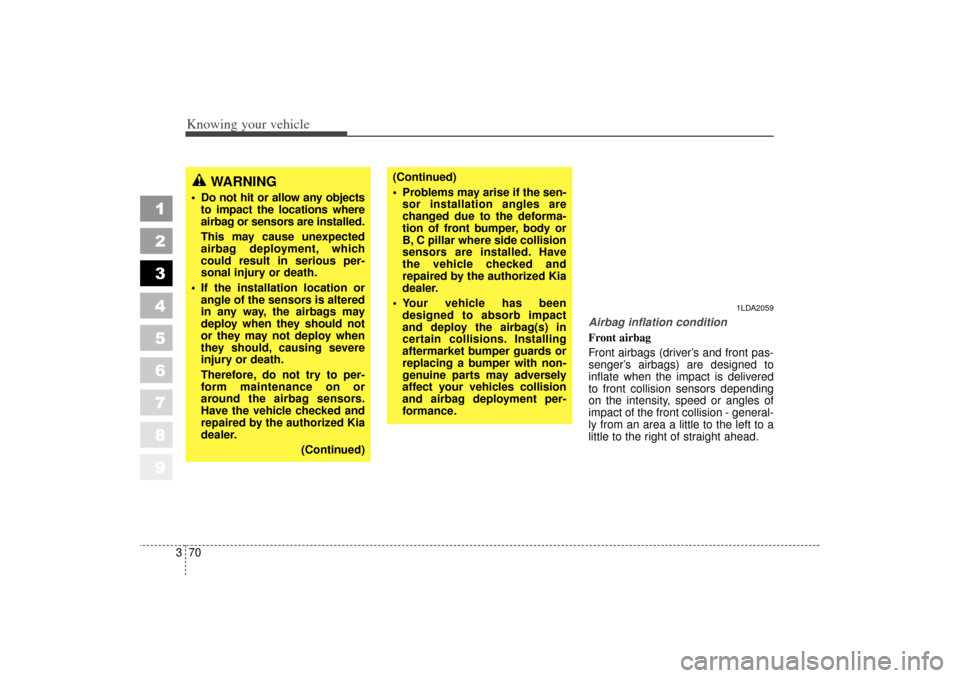
Knowing your vehicle70
3
1
2
3
4
5
6
7
8
9
Airbag inflation condition
Front airbag
Front airbags (driver ’s and front pas-
senger’ s airbags) are designed to
inflate when the impact is delivered
to front collision sensors depending
on the intensity, speed or angles of
impact of the front collision - general-
ly from an area a little to the left to a
little to the right of straight ahead.
WARNING
Do not hit or allow any objects to impact the locations where
airbag or sensors are installed.
This may cause unexpected
airbag deployment, which
could result in serious per-
sonal injury or death.
If the installation location or angle of the sensors is altered
in any way, the airbags may
deploy when they should not
or they may not deploy when
they should, causing severe
injury or death.
Therefore, do not try to per-
form maintenance on or
around the airbag sensors.
Have the vehicle checked and
repaired by the authorized Kia
dealer.
(Continued)
(Continued)
Problems may arise if the sen-sor installation angles are
changed due to the deforma-
tion of front bumper, body or
B, C pillar where side collision
sensors are installed. Have
the vehicle checked and
repaired by the authorized Kia
dealer.
Your vehicle has been designed to absorb impact
and deploy the airbag(s) in
certain collisions. Installing
aftermarket bumper guards or
replacing a bumper with non-
genuine parts may adversely
affect your vehicles collision
and airbag deployment per-
formance.
1LDA2059
LD CAN (ENG) new 3-1~.qxd 7/29/05 10:29 AM Page 70
Page 82 of 273

371
1
2
3
4
5
6
7
8
9
Knowing your vehicle
Side airbag (if equipped)
Side airbags (side and curtain
airbags) are designed to inflate when
the impact is delivered to side colli-
sion sensors depending on the
strength, speed or angles of impact
of side impact collision or rollover by
the side impact.Although the front airbags (driver
’s
and front passenger’ s airbags) are
designed to inflate only in frontal col-
lision, it may inflate in any collision if
front impact sensors are delivered
with certain impact.
Side airbags (side and curtain
airbags) are designed to inflate only
in side impact collision, it may inflate
in any collision if side impact sensors
are delivered with certain impact. In other words, they may inflate in
accidents such as slant collision or
impact, collision or impact where the
front portion of the vehicle goes
under a vehicle with a higher ground
clearance (bus or truck), collision
with a utility pole or rollover.
Therefore, drive safely at all times.
If the vehicle chassis is impacted by
bumps or objects on unimproved
roads or sidewalks, airbags may
deploy. Drive carefully on unim-
proved roads or on surfaces not
designed for vehicle traffic.
To protect occupants, front airbags
or pre-tensioner seat belts may
deploy in certain side impact colli-
sions.
1LDE20601LDA2057
LD CAN (ENG) new 3-1~.qxd 7/29/05 10:29 AM Page 71
Page 83 of 273

Knowing your vehicle72
3
1
2
3
4
5
6
7
8
9
Airbag non-inflation conditions
In collisions, the vehicle safety
belts are sufficient to protect the
vehicle occupants and the airbags
may not deploy. In some cases,
deploying airbags in low-speed
collisions can cause a secondary
impact to the occupants (light abra-
sions, cuts, burns, etc.), or loss of
vehicle control.
Airbags may not inflate in rear col-
lisions, because occupants are
moved backward by the force of
the impact. In this case, the airbags
do not provide proper protection.
Front airbags may not inflate in
side impact collision, because
occupants move to the direction of
the collision, and thus front airbag
deployment does not provide prop-
er protection.
However, side or curtain airbags (if
equipped) may inflate depending
on the intensity, vehicle speed and
angles of impact.
1GHA2273
1LDA2061
1LDN2063
LD CAN (ENG) new 3-1~.qxd 7/29/05 10:29 AM Page 72
Page 84 of 273
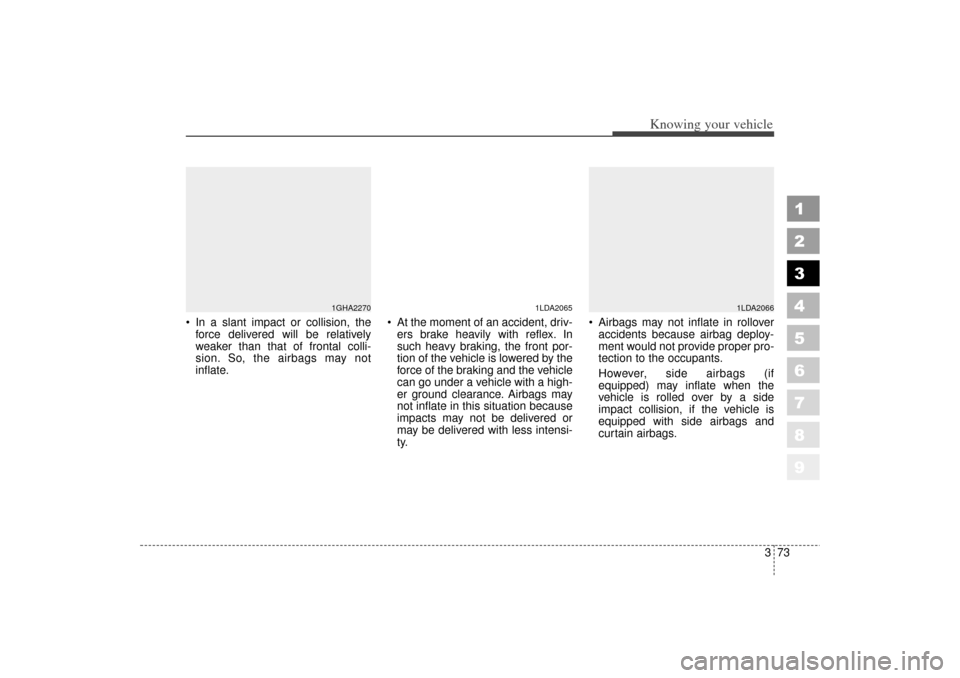
373
1
2
3
4
5
6
7
8
9
Knowing your vehicle
In a slant impact or collision, the
force delivered will be relatively
weaker than that of frontal colli-
sion. So, the airbags may not
inflate.
At the moment of an accident, driv-
ers brake heavily with reflex. In
such heavy braking, the front por-
tion of the vehicle is lowered by the
force of the braking and the vehicle
can go under a vehicle with a high-
er ground clearance. Airbags may
not inflate in this situation because
impacts may not be delivered or
may be delivered with less intensi-
ty.
Airbags may not inflate in rollover
accidents because airbag deploy-
ment would not provide proper pro-
tection to the occupants.
However, side airbags (if
equipped) may inflate when the
vehicle is rolled over by a side
impact collision, if the vehicle is
equipped with side airbags and
curtain airbags.
1GHA2270
1LDA2065
1LDA2066
LD CAN (ENG) new 3-1~.qxd 7/29/05 10:29 AM Page 73
Page 85 of 273

Knowing your vehicle74
3
1
2
3
4
5
6
7
8
9
Airbags may not inflate if the vehi-
cle collides with objects such as
utility poles or trees, where the
point of impact is concentrated to
one area and the full force of the
impact is not delivered to the sen-
sors.
How does the airbag system
operate Airbag only operates when the
ignition switch is turned to ON or
START position.
Airbags inflate instantly in the
event of serious frontal or side col-
lision (if equipped with side airbag
or curtain airbag) in order to help
protect the occupants from serious
physical injury.
There is no single speed at which
the airbags will inflate.
Generally, airbags are designed to
inflate by the severity of a collision
and its direction. These two factors
determine whether the sensors
send out an electronic deploy-
ment/inflation signal.
Airbag deployment depends on a
number of factors including vehicle
speed, angles of impact and the
density and stiffness of the vehi-
cles or objects which your vehicle
hits in the collision. Though, factors
are not limited to those mentioned
above.
The front airbags will completely
inflate and deflate in an instant.
It is virtually impossible for you to
see the airbags inflate during an
accident. It is much more likely that
you will simply see the deflated
airbags hanging out of their stor-
age compartments after the colli-
sion.
1LDA2067
LD CAN (ENG) new 3-1~.qxd 7/29/05 10:29 AM Page 74
Page 86 of 273
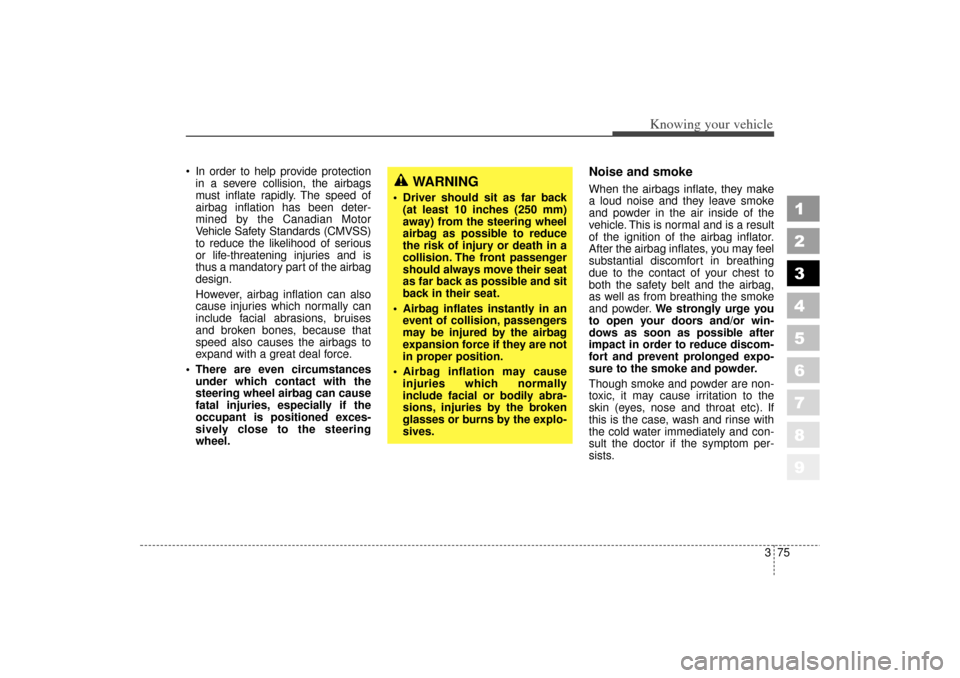
375
1
2
3
4
5
6
7
8
9
Knowing your vehicle
In order to help provide protection
in a severe collision, the airbags
must inflate rapidly. The speed of
airbag inflation has been deter-
mined by the Canadian Motor
Vehicle Safety Standards (CMVSS)
to reduce the likelihood of serious
or life-threatening injuries and is
thus a mandatory part of the airbag
design.
However, airbag inflation can also
cause injuries which normally can
include facial abrasions, bruises
and broken bones, because that
speed also causes the airbags to
expand with a great deal force.
There are even circumstances under which contact with the
steering wheel airbag can cause
fatal injuries, especially if the
occupant is positioned exces-
sively close to the steering
wheel.
Noise and smokeWhen the airbags inflate, they make
a loud noise and they leave smoke
and powder in the air inside of the
vehicle. This is normal and is a result
of the ignition of the airbag inflator.
After the airbag inflates, you may feel
substantial discomfort in breathing
due to the contact of your chest to
both the safety belt and the airbag,
as well as from breathing the smoke
and powder. We strongly urge you
to open your doors and/or win-
dows as soon as possible after
impact in order to reduce discom-
fort and prevent prolonged expo-
sure to the smoke and powder.
Though smoke and powder are non-
toxic, it may cause irritation to the
skin (eyes, nose and throat etc). If
this is the case, wash and rinse with
the cold water immediately and con-
sult the doctor if the symptom per-
sists.
WARNING
Driver should sit as far back (at least 10 inches (250 mm)
away) from the steering wheel
airbag as possible to reduce
the risk of injury or death in a
collision. The front passenger
should always move their seat
as far back as possible and sit
back in their seat.
Airbag inflates instantly in an event of collision, passengers
may be injured by the airbag
expansion force if they are not
in proper position.
Airbag inflation may cause injuries which normally
include facial or bodily abra-
sions, injuries by the broken
glasses or burns by the explo-
sives.
LD CAN (ENG) new 3-1~.qxd 7/29/05 10:29 AM Page 75
Page 87 of 273
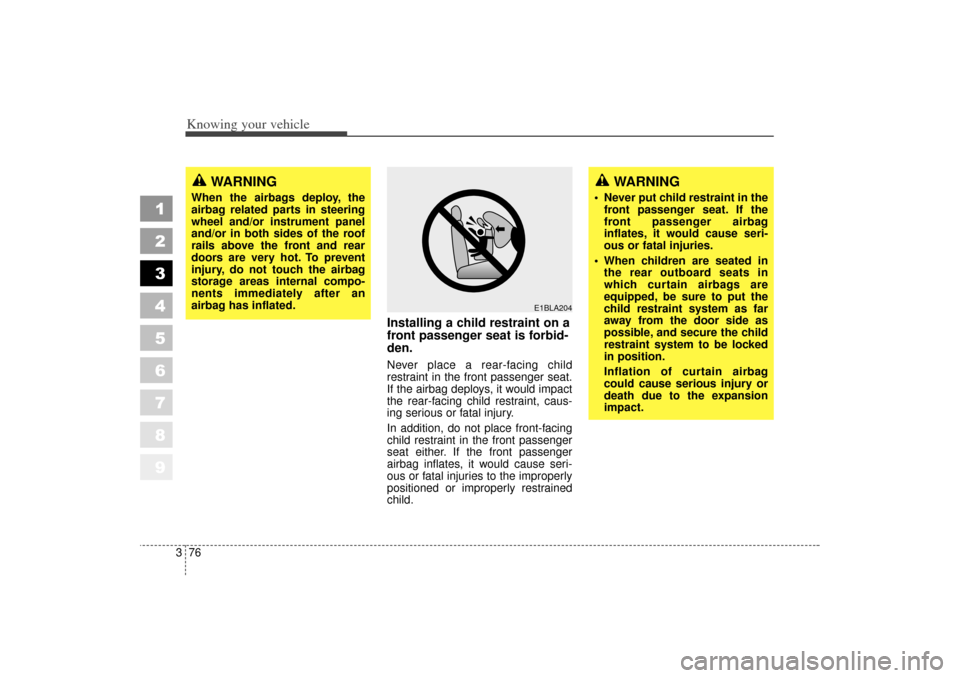
Knowing your vehicle76
3
1
2
3
4
5
6
7
8
9
Installing a child restraint on a
front passenger seat is forbid-
den.Never place a rear-facing child
restraint in the front passenger seat.
If the airbag deploys, it would impact
the rear-facing child restraint, caus-
ing serious or fatal injury.
In addition, do not place front-facing
child restraint in the front passenger
seat either. If the front passenger
airbag inflates, it would cause seri-
ous or fatal injuries to the improperly
positioned or improperly restrained
child.
WARNING
Never put child restraint in the
front passenger seat. If the
front passenger airbag
inflates, it would cause seri-
ous or fatal injuries.
When children are seated in the rear outboard seats in
which curtain airbags are
equipped, be sure to put the
child restraint system as far
away from the door side as
possible, and secure the child
restraint system to be locked
in position.
Inflation of curtain airbag
could cause serious injury or
death due to the expansion
impact.
WARNING
When the airbags deploy, the
airbag related parts in steering
wheel and/or instrument panel
and/or in both sides of the roof
rails above the front and rear
doors are very hot. To prevent
injury, do not touch the airbag
storage areas internal compo-
nents immediately after an
airbag has inflated.
E1BLA204
LD CAN (ENG) new 3-1~.qxd 7/29/05 10:29 AM Page 76
Page 88 of 273
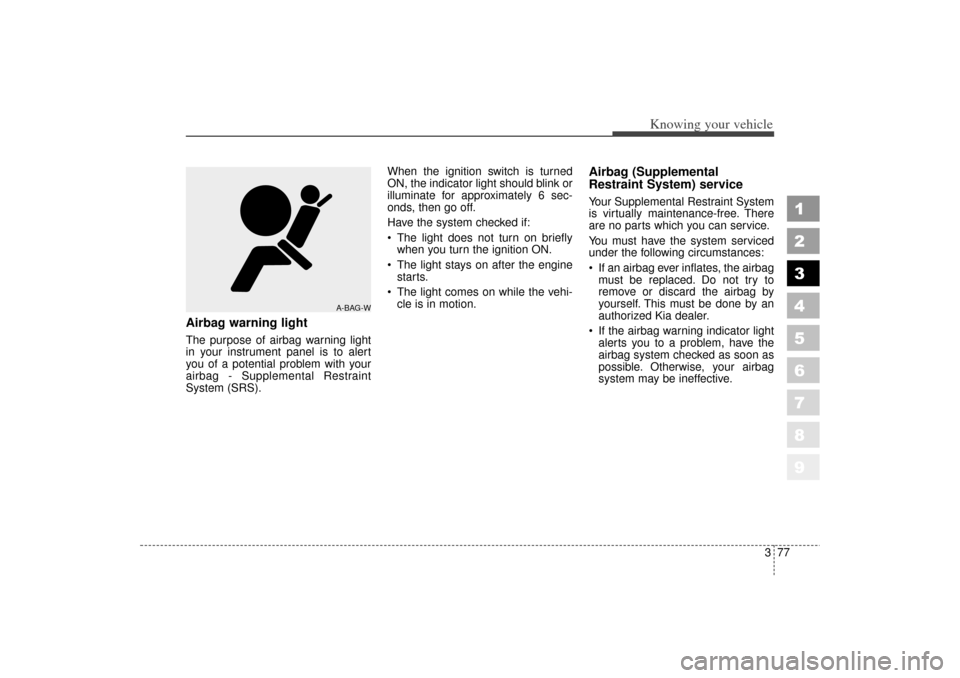
377
1
2
3
4
5
6
7
8
9
Knowing your vehicle
Airbag warning lightThe purpose of airbag warning light
in your instrument panel is to alert
you of a potential problem with your
airbag - Supplemental Restraint
System (SRS).When the ignition switch is turned
ON, the indicator light should blink or
illuminate for approximately 6 sec-
onds, then go off.
Have the system checked if:
The light does not turn on briefly
when you turn the ignition ON.
The light stays on after the engine
starts.
The light comes on while the vehi-
cle is in motion.
Airbag (Supplemental
Restraint System) service Your Supplemental Restraint System
is virtually maintenance-free. There
are no parts which you can service.
You must have the system serviced
under the following circumstances:
If an airbag ever inflates, the airbag
must be replaced. Do not try to
remove or discard the airbag by
yourself. This must be done by an
authorized Kia dealer.
If the airbag warning indicator light
alerts you to a problem, have the
airbag system checked as soon as
possible. Otherwise, your airbag
system may be ineffective.
A-BAG-W
LD CAN (ENG) new 3-1~.qxd 7/29/05 10:29 AM Page 77
Page 89 of 273
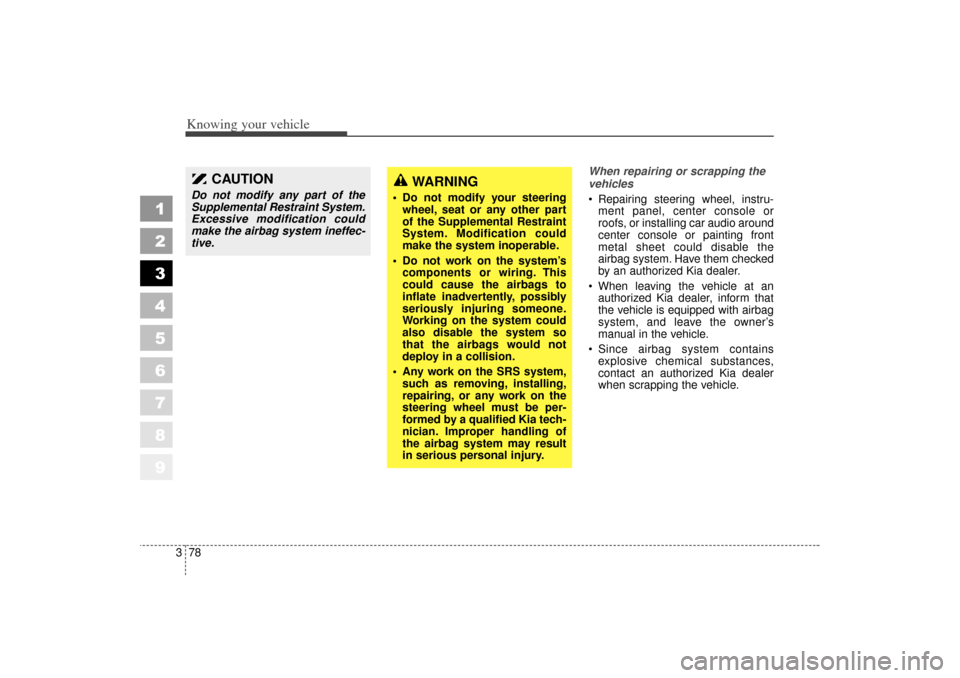
Knowing your vehicle78
3
1
2
3
4
5
6
7
8
9
When repairing or scrapping the
vehicles
Repairing steering wheel, instru-
ment panel, center console or
roofs, or installing car audio around
center console or painting front
metal sheet could disable the
airbag system. Have them checked
by an authorized Kia dealer.
When leaving the vehicle at an
authorized Kia dealer, inform that
the vehicle is equipped with airbag
system, and leave the owner’ s
manual in the vehicle.
Since airbag system contains
explosive chemical substances,
contact an authorized Kia dealer
when scrapping the vehicle.
CAUTION
Do not modify any part of the
Supplemental Restraint System.
Excessive modification could
make the airbag system ineffec-
tive.
WARNING
Do not modify your steering
wheel, seat or any other part
of the Supplemental Restraint
System. Modification could
make the system inoperable.
Do not work on the system’s components or wiring. This
could cause the airbags to
inflate inadvertently, possibly
seriously injuring someone.
Working on the system could
also disable the system so
that the airbags would not
deploy in a collision.
Any work on the SRS system, such as removing, installing,
repairing, or any work on the
steering wheel must be per-
formed by a qualified Kia tech-
nician. Improper handling of
the airbag system may result
in serious personal injury.
LD CAN (ENG) new 3-1~.qxd 7/29/05 10:29 AM Page 78
Page 90 of 273

379
1
2
3
4
5
6
7
8
9
Knowing your vehicle
Airbag warning labelAirbag warning labels which are now required by the Canadian Motor Vehicle Safety Standards (CMVSS) are
attached to alert driver and passengers of potential risk of airbag system.
Note that these government warnings focus on the risk to children, Kia also wants you to be aware of the risks which
adults are exposed to. Those have been described in previous pages.
5LDN2068/1LDN2069A/1LDN2074/1LDE2069
➀
(if equipped)
(if equipped)
➁
➂
LD CAN (ENG) new 3-1~.qxd 7/29/05 10:29 AM Page 79